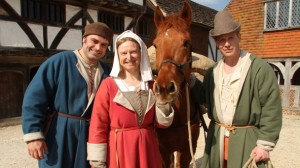 I mentioned this on The Anne Boleyn Files Facebook page last week but wanted to post here so that everyone who has access to the UK TV channel BBC2 can tune in and watch this series. Those of you who enjoyed The Victorian Farm, The Edwardian Farm, Wartime Farm, Tales of the Green Valley and The Victorian Pharmacy, will be excited about this six part series which starts this Wednesday (13th) at 9pm on BBC2.
I mentioned this on The Anne Boleyn Files Facebook page last week but wanted to post here so that everyone who has access to the UK TV channel BBC2 can tune in and watch this series. Those of you who enjoyed The Victorian Farm, The Edwardian Farm, Wartime Farm, Tales of the Green Valley and The Victorian Pharmacy, will be excited about this six part series which starts this Wednesday (13th) at 9pm on BBC2.
Here is the blurb about the programme from the BBC Media Centre:
“Following the long-running success of BBC Two’s living history series, Victorian, Edwardian and Wartime Farm, this autumn BBC Two takes up residence in the stunning medieval landscape of Weald and Downland Open Air Museum in Chichester to explore life on a Tudor Monastery Farm, complete with the greatest variety of 15th and 16th century buildings in the country.
Archaeologist Peter Ginn and historian Ruth Goodman, who is also a leading specialist in Tudor domestic life, return to front this six-part series. They are joined for the first-time by archaeologist Tom Pinfold to take on the role of the lay-folk who did the bulk of the farming and craftwork within monastic lands.
The team is turning the clock back to the year 1500 – a great turning point in British history. After centuries of war and plague, the nation was enjoying newfound stability and prosperity under the reign of its first Tudor King, Henry VII. But it also marked the last decades of the monastic system that had controlled every aspect of life for centuries.
For almost a 1000 years monasteries dominated the British landscape and were at the heart of the way medieval life was organised. Up to a quarter of the landed wealth in the Kingdom belonged to the Church and much of it was rented to farmers like Peter, Tom and Ruth.
From sheep farming and harvesting to fashioning a printing press and building a Tudor clock, the team will be put through their paces to give viewers a real-life account of what life would have been like at this time.
Tackling not just a new era but also a whole new way of life, scrupulous contemporary record-keeping and the latest archaeological finds will allow the team to pull this long-forgotten world into focus, and explore the whole of early Tudor-life in microcosm.
As well as showing the operations of day-to-day life, the series will explore the intricacies of social structure: at the relationship between the lay workforce and the inner sanctum, and between the wider world and the whole monastic community.”
There is also further information on the Exeter University website because Professor James Clark, of Exeter University, was the programme consultant and also appears in it as the team’s guide and mentor – see http://www.exeter.ac.uk/news/featurednews/title_333067_en.html
See the BBC2 Website for more details on episode one and the series.
Source: BBC Media Centre.
By the way, the book to accompany the series is already on Amazon UK – click here.